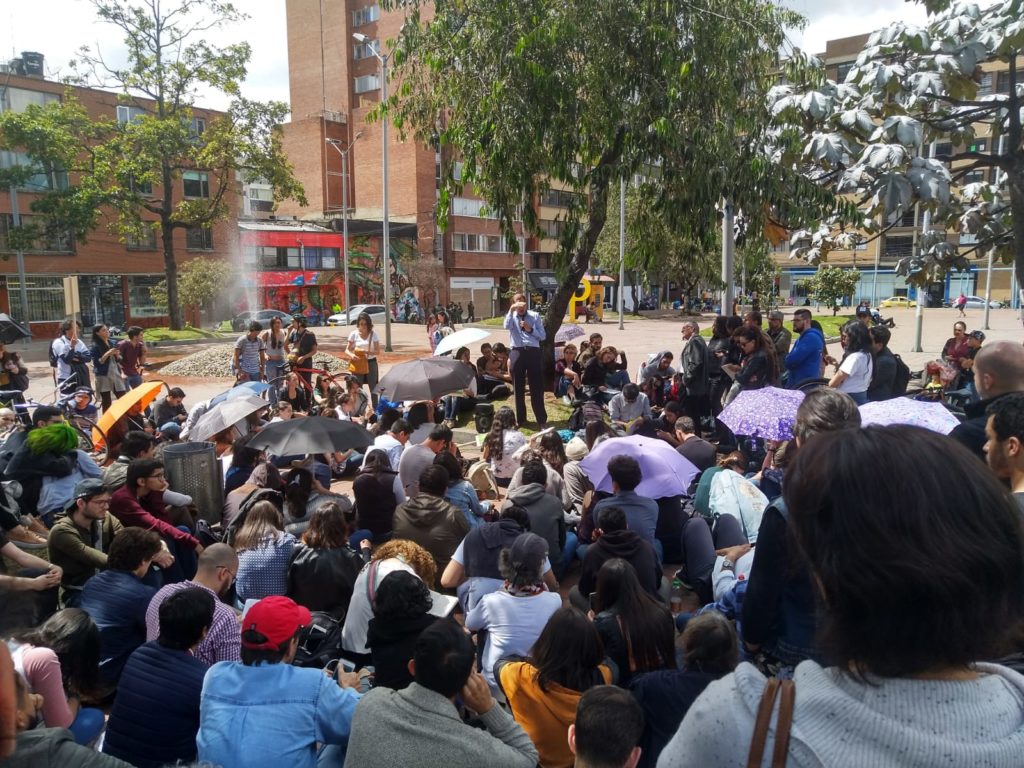Professors democratise knowledge with free public event.

A diverse crowd gathers in Parque de los Hippies for Clases a las Calles to learn about topics related to the national strike. Photo: Lukas Kaldenhoff
If education is a public right, why should classrooms be restricted to confined spaces in the hallowed halls of academics? To combat this exclusivity, a group of professors at Bogotá’s Universidad de Los Andes is working to democratise knowledge through the Clase a las Calles (classes on the streets) initiative.
Los Andes history professor Ana María Otero-Cleves started the Clases a las Calles initiative back in 2016 ahead of the infamous Colombian referendum on the peace accords. Since those first open-air course offerings, the group has given over 200 free lectures throughout the city, led by professors from several of the city’s institutions.
On Tuesday, at Chapinero’s Parque de los Hippies, the group hosted a national strike-themed version of Clases a las Calles titled: “What is at stake in this strike?”
Read all our coverage on Colombia’s national strike
David Soto, who described himself as an “unemployed student,” attended several of the day’s lectures, including those that covered the implementation of the peace accords and the state of the environment.
“I’m interested in getting to know the different points of view of those of us who support the strike,” said Soto.
“Like the petitions that we’ve made and they ‘why’ of it all. I want to educate myself on the ‘why’ of the strike and not just rely on broad strokes.”
The event kicked off at 10.30am in Bogotá’s blistering December sun with Professor Marc Hoffstetter’s talk on what is really at play in Colombia’s tributary and pension reform processes. The main theme of the discussion was to question who should be contributing to the system, and how much.
Then, professorial duo Darío Maldonado and Fabio Sánchez took on the complex topic of the state’s educational goals, emphasising the slowness of the government’s implementation of education initiatives like the expansion of public higher education. Following were talks titled “Where are we with the implementation of the peace accords?” and “Corruption and the management of public resources,” before professor Juan Camilo Cárdenas wrapped up the day with a fact-filled, comprehensive discussion on the future of the environment.
Cárdenas, who holds a PhD in Environmental and Resource Economics from the University of Massachusetts at Amherst, is a known scholar of the environment and its intrinsic relation to politics, economics, and social inequality. One of the major questions we face, according to Cárdenas, is how much we’re willing to give up in the short term in order to slow down the damage we are doing to the planet.
“To favour the future, we have to sacrifice the present,” said Cárdenas.
He localised his talk by discussing issues like potable water sourcing and gold deposits in the Páramo of Santurbán and the environmentally disastrous effects of Colombia’s ranching industry.
Cárdenas went on to posit that, as a society, we are not ready to tackle the epic scale of the environmental consequences we have created and that ultimately, social inequality is at the root of these issues.
After the event, industrial engineering student Juan Bastidas was sitting on a patch of grass with his friends, enjoying a free oncesitas snack courtesy of health food purveyor, Slow Foods Bogotá.
“You see it here with [the food] they’ve just handed out, you really see the unity of the people. Especially in these kinds of activities, these kinds of more critical activities that invite people to march with more specific motivations and feeling more informed,” said Bastidas.
“I think it’s really awesome because these things make the strike less exclusive by maybe including older people, more kids, and involving more people overall. It gives another face to the strike.”




